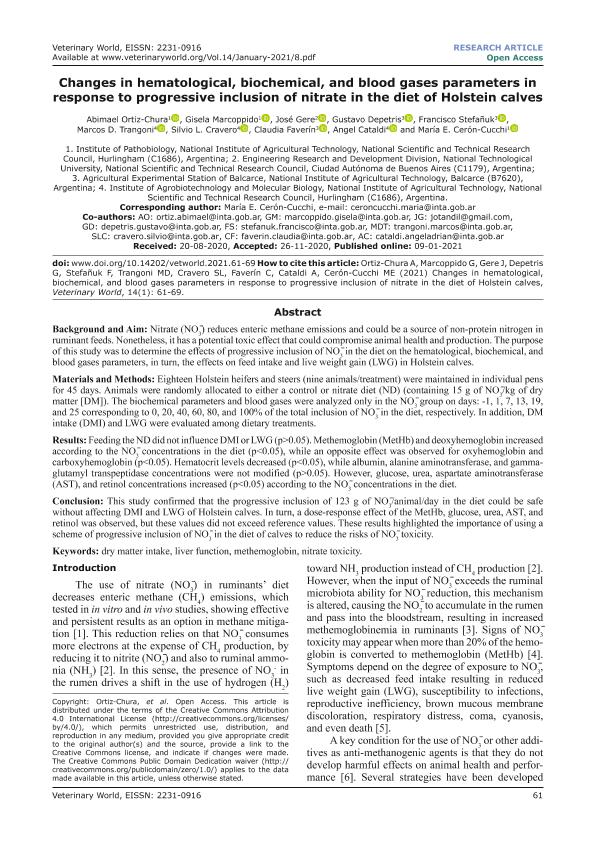Artículo
Changes in hematological, biochemical, and blood gases parameters in response to progressive inclusion of nitrate in the diet of Holstein calves
Ortiz Chura, Abimael ; Marcoppido, Gisela Ariana
; Marcoppido, Gisela Ariana ; Gere, José Ignacio
; Gere, José Ignacio ; Depetris, Gustavo Jesus; Stefañuk, Francisco; Trangoni, Marcos David; Cravero, Silvio Lorenzo Pedro; Faverin, Claudia; Cataldi, Angel Adrian
; Depetris, Gustavo Jesus; Stefañuk, Francisco; Trangoni, Marcos David; Cravero, Silvio Lorenzo Pedro; Faverin, Claudia; Cataldi, Angel Adrian ; Cerón Cucchi, María Esperanza
; Cerón Cucchi, María Esperanza
 ; Marcoppido, Gisela Ariana
; Marcoppido, Gisela Ariana ; Gere, José Ignacio
; Gere, José Ignacio ; Depetris, Gustavo Jesus; Stefañuk, Francisco; Trangoni, Marcos David; Cravero, Silvio Lorenzo Pedro; Faverin, Claudia; Cataldi, Angel Adrian
; Depetris, Gustavo Jesus; Stefañuk, Francisco; Trangoni, Marcos David; Cravero, Silvio Lorenzo Pedro; Faverin, Claudia; Cataldi, Angel Adrian ; Cerón Cucchi, María Esperanza
; Cerón Cucchi, María Esperanza
Fecha de publicación:
01/2021
Editorial:
Veterinary World
Revista:
Veterinary World
ISSN:
0972-8988
e-ISSN:
2231-0916
Idioma:
Inglés
Tipo de recurso:
Artículo publicado
Clasificación temática:
Resumen
Background and Aim: Nitrate (NO3) reduces enteric methane emissions and could be a source of non-protein nitrogen in ruminant feeds. Nonetheless, it has a potential toxic effect that could compromise animal health and production. The purpose of this study was to determine the effects of progressive inclusion of NO3in the diet on the hematological, biochemical, and blood gases parameters, in turn, the effects on feed intake and live weight gain (LWG) in Holstein calves. Materials and Methods: Eighteen Holstein heifers and steers (nine animals/treatment) were maintained in individual pens for 45 days. Animals were randomly allocated to either a control or nitrate diet (ND) (containing 15 g of NO3/kg of dry matter [DM]). The biochemical parameters and blood gases were analyzed only in the NO3group on days: -1, 1, 7, 13, 19, and 25 corresponding to 0, 20, 40, 60, 80, and 100% of the total inclusion of NO3in the diet, respectively. In addition, DM intake (DMI) and LWG were evaluated among dietary treatments. Results: Feeding the ND did not influence DMI or LWG (p>0.05). Methemoglobin (MetHb) and deoxyhemoglobin increased according to the NO3concentrations in the diet (p<0.05), while an opposite effect was observed for oxyhemoglobin and carboxyhemoglobin (p<0.05). Hematocrit levels decreased (p<0.05), while albumin, alanine aminotransferase, and gammaglutamyl transpeptidase concentrations were not modified (p>0.05). However, glucose, urea, aspartate aminotransferase (AST), and retinol concentrations increased (p<0.05) according to the NO3concentrations in the diet. Conclusion: This study confirmed that the progressive inclusion of 123 g of NO3/animal/day in the diet could be safe without affecting DMI and LWG of Holstein calves. In turn, a dose-response effect of the MetHb, glucose, urea, AST, and retinol was observed, but these values did not exceed reference values. These results highlighted the importance of using a scheme of progressive inclusion of NO3in the diet of calves to reduce the risks of NO3toxicity.
Palabras clave:
DRY MATTER INTAKE
,
LIVER FUNCTION
,
METHEMOGLOBIN
,
NITRATE TOXICITY
Archivos asociados
Licencia
Identificadores
Colecciones
Articulos (IPVET)
Articulos de INSTITUTO DE PATOBIOLOGIA VETERINARIA
Articulos de INSTITUTO DE PATOBIOLOGIA VETERINARIA
Articulos(SEDE CENTRAL)
Articulos de SEDE CENTRAL
Articulos de SEDE CENTRAL
Citación
Ortiz Chura, Abimael; Marcoppido, Gisela Ariana; Gere, José Ignacio; Depetris, Gustavo Jesus; Stefañuk, Francisco; et al.; Changes in hematological, biochemical, and blood gases parameters in response to progressive inclusion of nitrate in the diet of Holstein calves; Veterinary World; Veterinary World; 14; 1; 1-2021; 61-69
Compartir
Altmétricas



